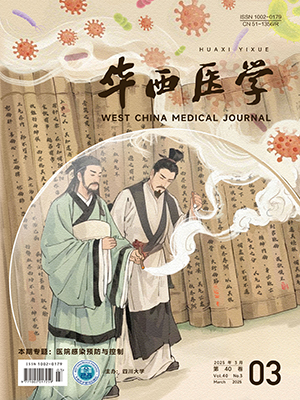Objective To analyze the status quo, problems and weak points of cleaning compliance in the Intensive Care Unit (ICU), and assess the intervention effects by evaluating the object surface cleaning quality in the ICU.
Methods Between September 1st and December 1st, 2014, fluorescence marker was used to mark the surfaces of medical instruments and objects in the ward which were supposed to be cleaned by the nursing and cleaning staff. The assessment of cleaning compliance was performed through observing the residual fluorescence. Then, targeted intervention was carried out for situations with a low cleaning compliance.
Results Before the intervention, the thorough cleaning rates of medical instruments in the Comprehensive ICU, Neurological ICU (NICU), and Chest ICU were respectively 43.3%, 31.4%, and 23.8%, and the thorough surface cleaning rates for those units in order were 67.1%, 60.5%, and 48.4%, respectively. After the first intervention, the cleaning rate of medical instruments in the Comprehensive ICU was 47.1%, which had no significant change (P=0.345), but the rate in the NICU and Chest ICU reached respectively 65.3% and 35.1%, which was significantly improved (P<0.05). The object surface cleaning rates were 73.3% and 58.1% in the Comprehensive ICU and Chest ICU after the first intervention, and there was no significant difference compared with those before the intervention (P>0.05), but the object surface cleaning rate in the NICU was significantly improved to 85.5% (P<0.05). After the second intervention, the medical equipment cleaning rates were 66.9%, 83.3%, and 57.4%, respectively for those three units, and compared with those before intervention, all the three were significantly improved (P<0.05). The object surface cleaning rates for NICU and Chest ICU were significantly raised to 85.6% and 84.2% (P<0.05), while it was 65.7% in the Comprehensive ICU and was not significantly improved (P=0.767).
Conclusion Observation and supervision through a feedback system can raise the cleaning compliance, which is helpful in controlling and preventing nosocomial infection.
Citation:
ZhuangHongdi, QiaoFu, HuangWenzhi, YinWeijia, ZongZhiyong. Intervention Studies on Object Surface Cleaning Compliance in the Ward Environment. West China Medical Journal, 2016, 31(3): 444-447. doi: 10.7507/1002-0179.201600120
Copy
Copyright © the editorial department of West China Medical Journal of West China Medical Publisher. All rights reserved
| 1. |
中华人民共和国卫生部. 关于印发医院感染诊断标准(试行)的通知[EB/OL]. (2001-01-03)[2015-06-23]. http://www.nhfpc.gov.cn/yzygj/s3593/200804/e19e4448378643a09913ccf2a055c79d.shtml.
|
| 2. |
胡莹, 杨红英, 杨旭. 2005至2009年铜绿假单胞菌感染分布及耐药性分析[J]. 检验医学, 2011, 26(11):797-798.
|
| 3. |
Goodman ER, Platt R, Bass R, et al. Impact of an environmental cleaning intervention on the presence of methicillin-resistant Staphylococcus aureus and vancomycin-resistant enterococci on surfaces in intensive care unit rooms[J]. Infect Control Hosp Epidemiol, 2008, 29(7):593-599.
|
| 4. |
Carling PC, Parry MM, Rupp ME, et al. Improving cleaning of the environment surrounding patients in 36 acute care hospitals[J]. Infect Control Hosp Epidemiol, 2008, 29(11):1035-1041.
|
| 5. |
谷继荣. 环境及物体表面消毒在预防和控制医院感染中的作用[J]. 中国感染控制杂志, 2012, 11(3):231-235.
|
| 6. |
李阳. 荧光标记法在环境物表清洁效果评价中的应用[J]. 江苏卫生事业管理, 2014, 6(25):41-42.
|
| 7. |
王太华, 南秀荣, 刘慧, 等. 医院感染管理模式初步探讨[J]. 中国医院管理, 2001, 21(3):47.
|
| 8. |
胡必杰, 倪晓平, 覃金爱. 医院环境物体表面清洁与消毒最佳实践[M]. 上海:上海科学技术出版社, 2012:27-40.
|
| 9. |
杨华明. 医院消毒与灭菌应逐步达到规范化要求[J]. 中国消毒学杂志, 2005, 22(1):100-102.
|
| 10. |
王丽香, 侯佳玲, 陈玉, 等. 三磷酸腺苷荧光检测在医疗器械清洗质量控制中的应用[J]. 华西医学, 2015, 30(1):105-107.
|
| 11. |
汪阳林, 韩宇洲, 杨静, 等. 医院环境清洁荧光检测的量化评估研究[J]. 华西医学, 2015, 30(7):1277-1279.
|
| 12. |
Khan A, Lampitoc M, Salaripour M, et al. Rapid control of a methicillin resistant Staphylococcus aureus (MRSA) outbreak in a medical surgical intensive care unit (ICU)[J]. Can J Infect Control, 2009, 24(1):12-16.
|
| 13. |
Wilson AP, Smyth D, Moore G, et al. The impact of enhanced cleaningwithin the intensive care unit on contamination of the near-patientenvironment with hospital pathogens:a randomized crossover study in critical care units in two hospitals[J]. Crit Care Med, 2011, 39:651-658.
|
| 14. |
尤洪兰. 重症监护室物体表面清洁消毒方案的改进及消毒效果观察[J]. 环境与健康杂志, 2012, 3(29):273-274.
|
- 1. 中华人民共和国卫生部. 关于印发医院感染诊断标准(试行)的通知[EB/OL]. (2001-01-03)[2015-06-23]. http://www.nhfpc.gov.cn/yzygj/s3593/200804/e19e4448378643a09913ccf2a055c79d.shtml.
- 2. 胡莹, 杨红英, 杨旭. 2005至2009年铜绿假单胞菌感染分布及耐药性分析[J]. 检验医学, 2011, 26(11):797-798.
- 3. Goodman ER, Platt R, Bass R, et al. Impact of an environmental cleaning intervention on the presence of methicillin-resistant Staphylococcus aureus and vancomycin-resistant enterococci on surfaces in intensive care unit rooms[J]. Infect Control Hosp Epidemiol, 2008, 29(7):593-599.
- 4. Carling PC, Parry MM, Rupp ME, et al. Improving cleaning of the environment surrounding patients in 36 acute care hospitals[J]. Infect Control Hosp Epidemiol, 2008, 29(11):1035-1041.
- 5. 谷继荣. 环境及物体表面消毒在预防和控制医院感染中的作用[J]. 中国感染控制杂志, 2012, 11(3):231-235.
- 6. 李阳. 荧光标记法在环境物表清洁效果评价中的应用[J]. 江苏卫生事业管理, 2014, 6(25):41-42.
- 7. 王太华, 南秀荣, 刘慧, 等. 医院感染管理模式初步探讨[J]. 中国医院管理, 2001, 21(3):47.
- 8. 胡必杰, 倪晓平, 覃金爱. 医院环境物体表面清洁与消毒最佳实践[M]. 上海:上海科学技术出版社, 2012:27-40.
- 9. 杨华明. 医院消毒与灭菌应逐步达到规范化要求[J]. 中国消毒学杂志, 2005, 22(1):100-102.
- 10. 王丽香, 侯佳玲, 陈玉, 等. 三磷酸腺苷荧光检测在医疗器械清洗质量控制中的应用[J]. 华西医学, 2015, 30(1):105-107.
- 11. 汪阳林, 韩宇洲, 杨静, 等. 医院环境清洁荧光检测的量化评估研究[J]. 华西医学, 2015, 30(7):1277-1279.
- 12. Khan A, Lampitoc M, Salaripour M, et al. Rapid control of a methicillin resistant Staphylococcus aureus (MRSA) outbreak in a medical surgical intensive care unit (ICU)[J]. Can J Infect Control, 2009, 24(1):12-16.
- 13. Wilson AP, Smyth D, Moore G, et al. The impact of enhanced cleaningwithin the intensive care unit on contamination of the near-patientenvironment with hospital pathogens:a randomized crossover study in critical care units in two hospitals[J]. Crit Care Med, 2011, 39:651-658.
- 14. 尤洪兰. 重症监护室物体表面清洁消毒方案的改进及消毒效果观察[J]. 环境与健康杂志, 2012, 3(29):273-274.




